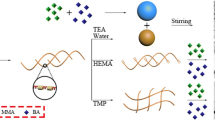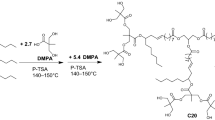Abstract
A serious of waterborne hydroxyl-functional polyurethane/acrylic (PUA) emulsions for two-component coatings was prepared by copolymerizing different weight ratios of hydroxyethyl acrylate (HEA)/butyl acrylate (BA) with methyl methacrylate and acrylic-terminated polyurethane dispersion via an emulsion process. The results showed that increasing the weight ratio of HEA/BA led to a decrease in the average particle sizes and a narrowing in the particle size distribution, but an increase in the viscosity of their emulsions. Meanwhile, their films showed increased thermal resistance, adhesion on substrate, tensile strength, and hardness, but decreased water resistance and enhanced wettability. When the emulsions were applied in two-component coatings, their water resistance was greatly improved and the wettability was reduced; in addition, their glass transition temperature, thermal stability, adhesion on substrate, tensile strength, and hardness were further increased. It was suggested that hydroxyl groups of PUA can not only engage in the intramolecular and/or intermolecular hydrogen bonding, but also form covalently crosslinked networks with polyisocyanate in their films.









Similar content being viewed by others
References
Chattopadhyay, DK, Raju, KVSN, “Structural Engineering of Polyurethane Coatings for High Performance Applications.” Prog. Polym. Sci., 32 352–418 (2007)
Brown, RA, Coogan, RG, Fortier, DG, Reeve, MS, Rega, JD, “Comparing and Contrasting the Properties of Urethane/Acrylic Hybrids with Those of Corresponding Blends of Urethane Dispersions and Acrylic Emulsions.” Prog. Org. Coat., 52 73–84 (2005)
Saeed, A, Shabir, G, “Synthesis of Thermally Stable High Gloss Water Dispersible Polyurethane/Polyacrylate Resins.” Prog. Org. Coat., 76 1135–1143 (2013)
Wei, YY, Luo, YW, Li, BF, Li, BG, “Polyurethane Acrylate Microgel Synthesized by Emulsion Polymerization Using Unsaturated Self-emulsified Polymer.” Colloid. Polym. Sci., 284 1171–1178 (2006)
Lopez, A, Degrandi-Contraires, E, Canetta, E, Creton, C, Keddie, JL, Asua, JM, “Waterborne Polyurethane-Acrylic Hybrid Nanoparticles by Miniemulsion Polymerization: Applications in Pressure-Sensitive Adhesives.” Langmuir, 27 3878–3888 (2011)
Xu, H, Qiu, F, Wang, Y, Yang, D, Wu, W, Chen, Z, Zhu, J, “Preparation, Mechanical Properties of Waterborne Polyurethane and Cross-Linked Polyurethane-Acrylate Composite.” J. Appl. Polym. Sci., 124 958–968 (2012)
Son, SJ, Kim, KB, Lee, YH, Lee, DJ, Kim, HD, “Effect of Acrylic Monomer Content on the Properties of Waterborne Poly(urethane-urea)/Acrylic Hybrid Materials.” J. Appl. Polym. Sci., 124 5113–5121 (2012)
Fiori, DE, Ley, DA, Quinn, RJ, “Effect of Particle Size Distribution on the Performance of Two-Component Water-Reducible Acrylic Polyurethane Coatings Using Tertiary Polyisocyanate Cross-Linkers.” J. Coat. Technol., 72 63–69 (2000)
Rahman, MM, Kim, HD, “Effect of Polyisocyanate Hardener on Waterborne Polyurethane Adhesive Containing Different Amounts of Ionic Groups.” Macromol. Res., 14 634–639 (2006)
Kong, X, Li, S, Qu, J, Chen, H, “Self-emulsifying Hydroxyl Acrylic Polymer Dispersions for Two Component Waterborne Polyurethane Coatings.” J. Macromol. Sci. A, 47 368–374 (2010)
Longenecker, R, Mu, T, Hanna, M, Burke, NAD, Stover, HDH, “Thermally Responsive 2-Hydroxylethyl Methacrylate Polymers: Soluble–Insoluble and Soluble–Insoluble Soluble Transitions.” Macromolecules, 44 8962–8971 (2011)
Sanna, R, Alzari, V, Nuvoli, D, Scognamillo, S, Marceddu, S, Mariani, A, “Polymer Hydrogels of 2-Hydroxylethyl Acrylate and Acrylic Acid Obtained by Frontal Polymerization.” J. Polym. Sci. Pol. Chem., 50 1515–1520 (2012)
Ismail, H, Ahmad, Z, Yew, FW, “Effect of Monomer Composition on Adhesive Performance for Waterborne Acrylic Pressure-Sensitive Adhesives.” J. Phys. Sci., 22 51–63 (2011)
Lopez, A, Degrandi, E, Canetta, E, Keddie, JL, Creton, C, Asua, JM, “Simultaneous Free Radical and Addition Miniemulsion Polymerization: Effect of the Diol on the Microstructure of Polyurethane-Acrylic Pressure-Sensitive Adhesives.” Polymer, 52 3021–3030 (2011)
Guo, YH, Li, SC, Wang, GS, Ma, W, Huang, Z, “Waterborne Polyurethane/Poly(n-butyl acrylic-styrene) Hybrid Emulsions: Particle Formation, Film Properties, and Application.” Prog. Org. Coat., 74 248–256 (2012)
Ma, G, Guan, T, Wu, J, Hou, C, Wang, G, Qin, G, Wang, B, “Effect of 2-Ethylhexyl Acrylate and N-Acryloylmorpholine on the Properties of Polyurethane/Acrylic Hybrid Materials.” J. Appl. Polym. Sci., (2014). doi:10.1002/app.41463
Chai, SL, Jin, MM, Tan, HM, “Comparative Study Between Core–Shell and Interpenetrating Network Structure Polyurethane/Polyacrylic Composite Emulsions.” Eur. Polym. J., 44 3306–3313 (2008)
Nanda, AK, Wicks, DA, “The Influence of the Ionic Concentration, Concentration of the Polymer, Degree of Neutralization and Chain Extension on Aqueous Polyurethane Dispersions Prepared by the Acetone Process.” Polymer, 47 1805–1811 (2006)
Lin, Y, Zhou, Y, Xu, C, Xie, A, Yang, M, Yang, S, Chen, H, “Study on Synthesis and Thickening Property of Hyperbranched Waterborne Polyurethane.” Prog. Org. Coat., 76 1302–1307 (2013)
Pardini, OR, Amalvy, JI, “FTIR, 1H-NMR Spectra, and Thermal Characterization of Water-Based Polyurethane/Acrylic Hybrids.” J. Appl. Polym. Sci., 107 1207–1214 (2008)
Sebenik, U, Krajnc, M, “Seeded semibatch Emulsion Copolymerization of Methyl Methacrylate and Butyl Acrylate Using Polyurethane Dispersion: Effect of Soft Segment Length on Kinetics.” Colloid. Surf. A, 233 51–62 (2004)
Acknowledgments
This research is financially supported by Shanxi Scholarship Council of China (No. 2012-8) and Scientific Research Foundation of Shanxi Province, China (No. 20111101059).
Author information
Authors and Affiliations
Corresponding author
Rights and permissions
About this article
Cite this article
Ma, G., Guan, T., Hou, C. et al. Preparation, properties and application of waterborne hydroxyl-functional polyurethane/acrylic emulsions in two-component coatings. J Coat Technol Res 12, 505–512 (2015). https://doi.org/10.1007/s11998-014-9647-y
Published:
Issue Date:
DOI: https://doi.org/10.1007/s11998-014-9647-y




